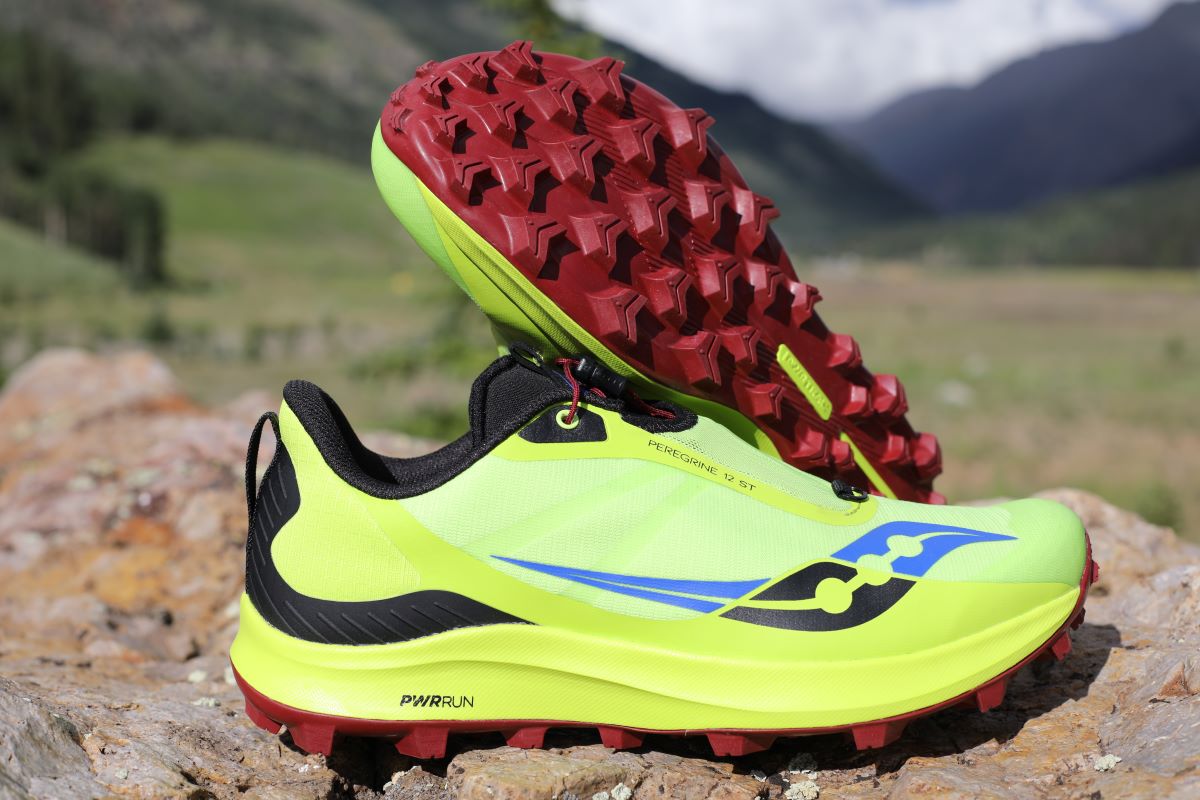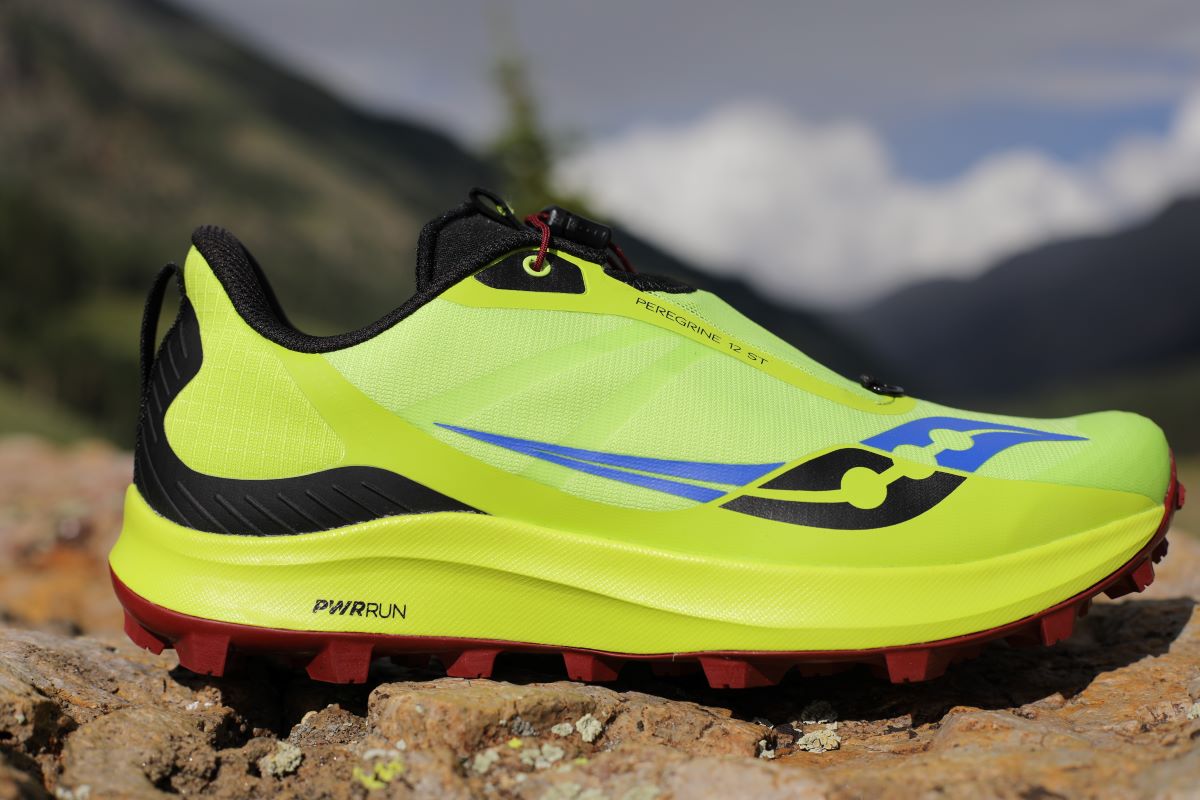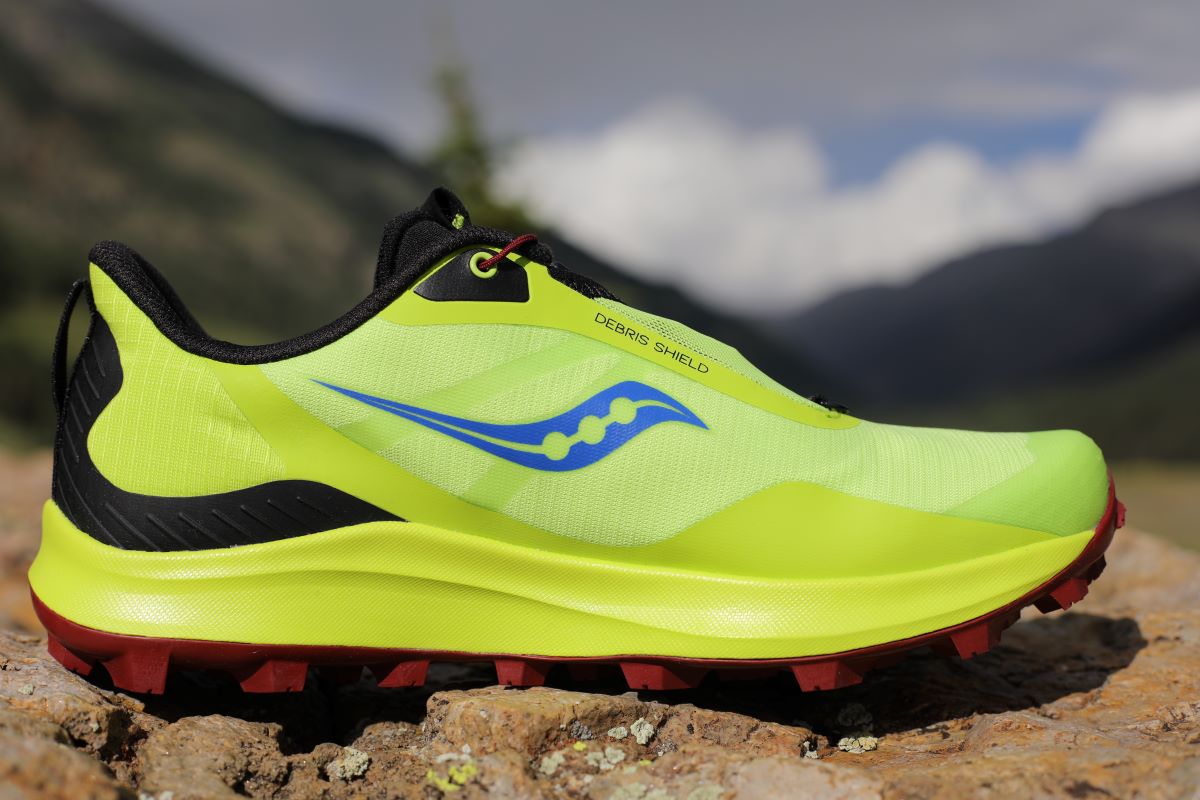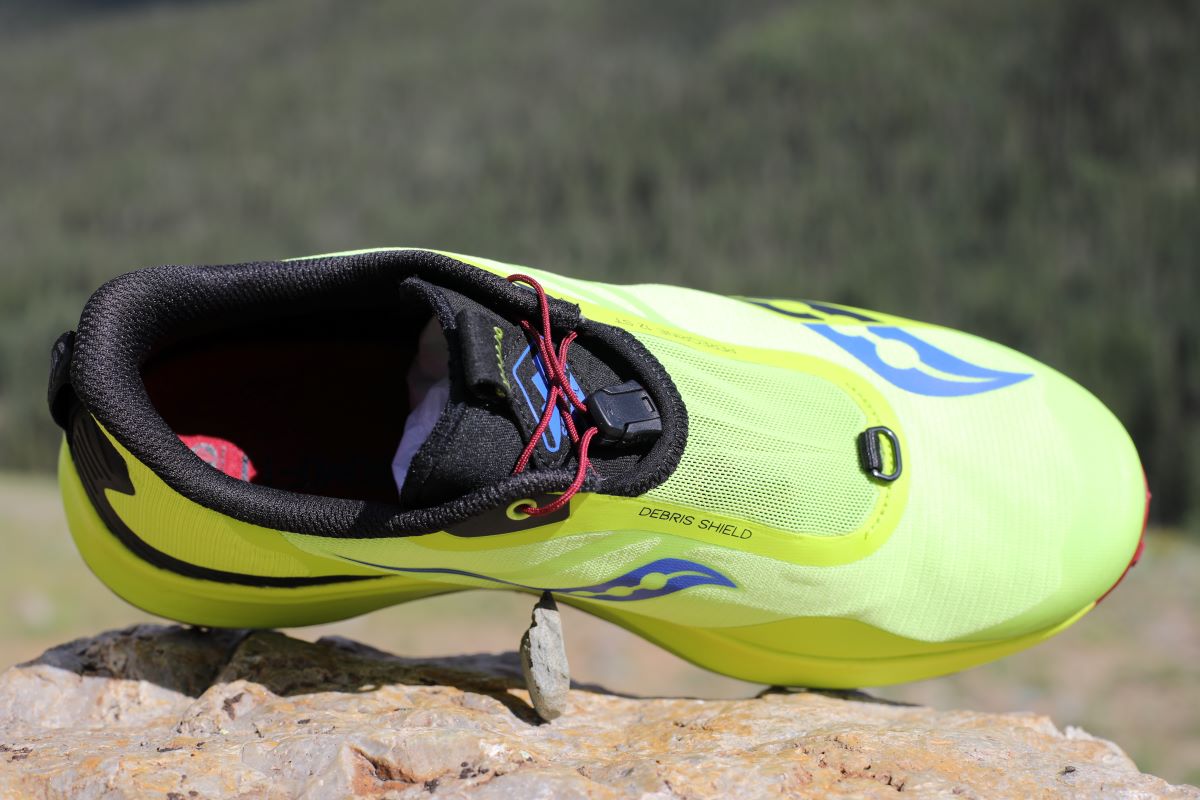For the latest on the Saucony Peregrine, check out our Saucony Peregrine 15 review.
Our Favorite Trail Running Shoes
Check out our Best Trail Running Shoes article to learn about our current favorite trail running shoes!
Saucony Peregrine 12 ST Review
The Saucony Peregrine 12 ST ($140) sports the upper and outsole of a mud shoe and the midsole of a mountain running shoe, making it a true mud shoe and mountain running shoe chimera.
As you may have already guessed, the Saucony Peregrine 12 ST is the soft-terrain version of the much-loved Saucony Peregrine 12 — make sure to check out our Saucony Peregrine 12 review. Essentially, this shoe takes one of our favorite features of Peregrine 12, the 26.5-to-22.5-millimeter-drop PWRRUN midsole, and pairs it with widely spaced 6.5-millimeter lugs, a tightly woven mesh upper, and speed laces.
But the overall last and fit remain about the same so this shoe feels only marginally different. It’s a bit clunkier but still comfortable on the hardpack and immensely more grippy in the wet stuff. It has an actual weight of 10.8 ounces (305 grams) for a men’s size 9.
When we tested this shoe alongside a dozen other mud shoes in Utah, Montana, and Colorado for our best trail running shoes for mud guide, it emerged as our favorite all-terrain mud shoe. We found it to be pretty ideal for people who live in the western U.S. and encounter mud on a seasonal basis.
Shop the Men's Saucony Peregrine 12 STShop the Women's Saucony Peregrine 12 ST
Saucony Peregrine 12 ST Upper
To keep out debris, the Saucony Peregrine 12 ST’s upper is constructed from more tightly woven fabric than the upper on the non-soft-terrain version. In our experience, it works. Very little mud worked its way through to the sock when running up and down muddy trails in the Wasatch Mountains of northern Utah where I live.
Though we didn’t test these trail running shoes in the desert or on the beach, it seems to follow that they would also resist both wet and dry sand quite well. Because the upper is tightly woven, this shoe doesn’t breathe quite as well as the non-soft-terrain version and was found to be quite warm in cooler weather.
Although the uppers on the Peregrine 12 ST and the non-soft-terrain version are made of slightly different mesh, they feel about the same around the foot. We found this shoe’s upper to feel snug in the midfoot but roomy in the toe and malleable enough not to impose any undue pressure anywhere. Overall, it’s comfortable.
A feature that differentiates the Peregrine 12 ST from the Peregrine 12 is the speed laces. Instead of regular laces, the ST utilizes a very thin static cord with a cordlock system for loosening and tightening them. It’s reminiscent of the laces found on many Salomon shoes, so if you like those, you’ll like these.
There are a few benefits to this system. For one, these laces don’t absorb water. This helps keep the overall weight of the shoe low when trail conditions remain soggy throughout the entirety of a run. Some traditional laces can also stretch when they become waterlogged, a problem that these laces prevent.
Because there is a mesh shield into which the laces tuck, they may be more secure than traditional laces for bushwhacking. The laces do feel extremely static, however, meaning they don’t have the give of normal laces. To get speculative for a second, this could make this shoe less comfortable for longer runs, but we have not yet experienced any lace-related discomfort.
Moreover, static laces are ideal for mud shoes. In the event that your foot gets stuck in the mud, secure laces will prevent your foot from popping out of the shoe.
Saucony Peregrine 12 ST Midsole
The midsole on the Saucony Peregrine 12 ST is made of the exact same PWRRUN foam found on the Peregrine 12. As we mentioned in our review of the latter, this midsole is a welcome departure from the last few iterations of these shoes because it is firm but comfortable while also being surprisingly light. The firmness of the midsole is balanced by a thick and cushy insole which increases the comfort of this shoe. And our testers who prefer neutral shoes were also pleased to find that this shoe does not have any high-density EVA built into areas of the midsole for stability or pronation prevention.
In our experience, all of these attributes translate well to soft-terrain performance. Most mud-specific shoes are low-ish to the ground with firm midsoles, operating under the assumption that the soft ground will provide the cushioning that the shoe does not. This firm and low design also lowers the runner’s center of gravity and keeps the shoe from feeling sloppy to prevent rolling an ankle on a buried, invisible obstacle.
Saucony Peregrine 12 ST Outsole
To dig into soft terrain, the Saucony Peregrine 12 ST is constructed with widely spaced 6.5-millimeter lugs. We found them to grip well in mud and dispense with it all the same. The tread grips well on wet rocks if you land right on the lugs and not in the middle of the outsole where there are no lugs. Beware not to land the middle or arch of the shoe on a wet root or you may be forced into attempting the accidental splits like one of our testers.
The lugs are probably one of the main things that ups the overall weight of this shoe. For a men’s size 9, the Peregrine 12 ST weighs 1.2 ounces more than the Peregrine 12. We also found that we could feel the lugs a bit when running on hardpack, which made this shoe feel a little clunky on that terrain. It wasn’t too bad, though, and actually totally acceptable if about half the run is wet, muddy, or snowy.
Some parts of the Wasatch Mountains foothills where I live are blessed with relentlessly sticky clay. In this environment, the Peregrine 12 ST gripped nearly as well as any mud-specific shoe we tested and let go of the mud in only a few steps. On the sloppiest early spring days, this clay overwhelmed every shoe we tested, and the Peregrine 12 ST was no different. It became a complete mudcake, as expected. Mud shoes can only do so much.
The rubber compound that Saucony uses is almost slick feeling, which may partly explain why it sheds mud so well. That said, it grips well on both wet and dry rock as one of our testers found when scrambling around the upper reaches of the Wasatch Mountains.
Saucony Peregrine 12 ST Overall Impressions
The Saucony Peregrine 12 ST stands apart from many mud shoes we tested in that it is not a one-trick pony. It has big 6.5-millimeter lugs, so it performs nearly as well as more myopic mud shoes in terms of grip and mud-shedding, but it can also move nimbly down the hardpack when the sun comes out.
Possibly more important than any of the nerdy details mentioned above, this shoe is simply fun. On a 14-mile run through Big Cottonwood Canyon and Millcreek Canyon in the Wasatch Mountains of Utah, one of our testers found all the possible conditions for which the Peregrine 12 ST was made.
For the first seven miles when the storms were still building in the west, this shoe felt light and comfortable on the hardpack. Black clouds rolled in and an early season monsoon turned the trail into a creek, forcing this trail shoe to prove that it was also a mud shoe. The Peregrine 12 ST did what it was designed to do, powering through wet, off-camber singletrack without slowing down.
The Saucony Peregrine 12 ST is a truly versatile chimera of a shoe; it’s a comfortable mountain and trail running shoe with lugs deep and wide enough to claw into mud and let it go just as quickly. If you’d like to learn more about where this shoe lands among iRunFar’s favorite mud running shoes, check out our best trail running shoes for mud guide.
Shop the Men's Saucony Peregrine 12 STShop the Women's Saucony Peregrine 12 ST
Call for Comments
- Have you used both the Saucony Peregrine 12 and the Saucony Peregrine 12 ST? How do they compare?
- Have you used the Peregrine 12 ST for fell running? How did it perform?
[Editor’s Note: If you’re affiliated (i.e., an employee, ambassador, etc.) with a brand, please share your relation in each of your comments on this article. Thanks!]
Our Favorite Trail Running Shoes
Check out our Best Trail Running Shoes article to learn about our current favorite trail running shoes!





